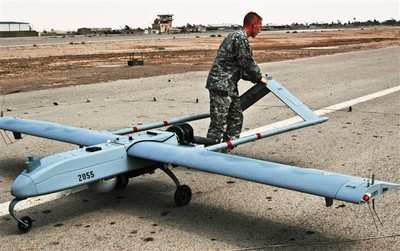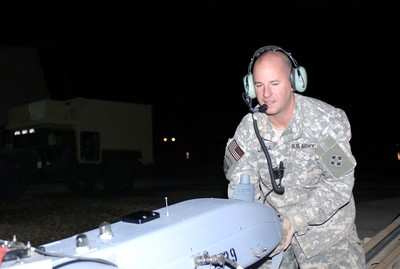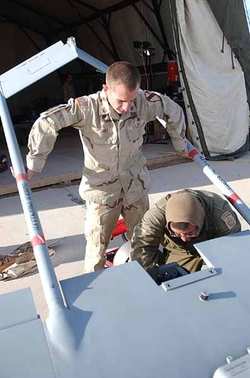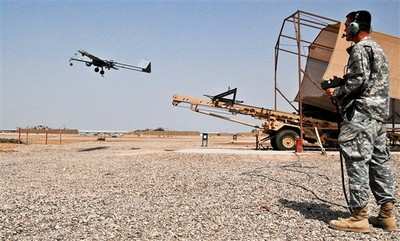Shadows Used For Recon Over Baghdad Neighborhoods
Since the dawn of aviation more than 100 years ago, militaries
throughout the world have pursued the development of unmanned
aerial vehicles to give them an edge over the enemy when conducting
combat operations. Today, the UAV is an imperative asset for troops
on the ground.

This is especially true for Multinational Division Baghdad
soldiers who conduct daily missions in and around the Iraqi
capital.
As the leading provider and provisional authority for
Multinational Division Baghdad's airspace, the 4th Infantry
Division Combat Aviation Brigade, based out of Fort Hood, TX
provides the launch and recovery for one of the Army's primary
reconnaissance tactical UAV assets: the Shadow.
Since its development about 10 years ago, the Shadow's use has
increased tenfold. It provides reconnaissance for almost all
Multinational Division Baghdad's combat operations. With
sophisticated optics, cameras and communications equipment, the
Shadow enables commanders on the ground to see the entire
battlefield in real time. Soldiers have reported that the Shadow
greatly contributes to the capture of criminals in the suburban
neighborhoods around Baghdad.
"For the most part, we have a UAV on station for the majority of
missions that involve the capture of high-value targets or
terrorists," explained Army Maj. Jonathan Shaffner, brigade
aviation officer and chief of operations for the 25th Infantry
Division's 2nd Stryker Brigade Combat Team, who hails from
Mansfield, Ohio. "The aircraft is an active contributor to the
actual apprehension of these criminals. It's hard to imagine combat
today without UAVs. The aircrafts' capabilities are continuously
improving, and they are beginning to do a lot of the same missions
as our manned aircraft."
Shaffner cited a recent operation north of Baghdad to find and
capture a man believed to be responsible for hostile acts against
coalition forces and the Iraqi people.

Upon entering the suspect's home, soldiers found he wasn't
there. But the Shadow was honed in on a suspicious vehicle nearby.
With the Shadow's camera fixed on the vehicle, its operator
reported to the ground commander that two men had fled from the
vehicle and were hiding in a nearby canal.
With precise accuracy, the Shadow operator reported the location
of the two individuals to the ground soldiers, who then apprehended
the suspects, one of whom was the operation's target. The event is
just one of the hundreds of examples of how tactical UAVs have
helped throughout Multinational Division Baghdad's area of
operations, Shaffner said.
Launch and recovery operations are the responsibility of the 4th
Infantry Division's Company G, 2nd Battalion, 4th Aviation
Regiment, Combat Aviation Battalion. Unlike a conventional unit,
Company G, also known as the "Guardian Angels," is made up of
soldiers from all across the area of operations.
UAV operators are assigned to their respective brigade combat
teams throughout the theater, but one platoon from each unit is
sent here for a predetermined amount of time to help to operate the
launch and recovery site. The platoons, made up of operators and
maintainers, are assigned or attached to the combat aviation
battalion during their stay at the Guardian Angels' tactical UAV
operations center.
The five major units that operate the site here include the 4th
Infantry Division's 1st and 3rd Brigade Combat Teams, with the
101st Airborne Division's 2nd Brigade Combat Team, the 10th
Mountain Division's 4th Brigade Combat Team, and the 25th Infantry
Division's 2nd Stryker Brigade Combat Team.

Shadow operators perform take-off and landing procedures from
the facility. The forward units throughout the area of operations
control the specific mission and flight path.
"All the aircraft are prepared and launched from here," said
Army Sgt. 1st Class Michael Horwath, from Vassar, Mich., the
company's senior noncommissioned officer. "Our guys fly them out,
hand them off to the brigade combat teams in theater and, at that
time, the specific brigade [tactical] UAV elements actually fly the
missions.
"At the conclusion of a Shadow mission," he continued, "the
brigades route the aircraft back into our air space, and the UAV
operators here pick the aircraft back up and land them. Once they
land, we conduct maintenance and prep them for another
mission."
The air vehicle uses a pneumatic launcher on take-off and is
recovered by a tactical automatic landing system, with no pilot
intervention on the runway. The aircraft is then stopped using an
arresting hook and cable system similar to the ones used on Navy
aircraft carriers.
Operating the Shadow is relatively cheap in comparison to
conventional Army aircraft. Each system -- three to four aircraft,
two ground stations, a launch trailer and support vehicles for
equipment and personnel -- costs roughly $10 million, depending on
equipment dynamics and accessories. When compared to an AH-64D
Apache attack helicopter, often used for some of the same
reconnaissance missions as the Shadows, the price differential and
fuel consumption are astronomically lower.
"The UAVs can provide at least 70 percent of the support you
would get from an attack helicopter -- minus the armament,"
Shaffner said. "The operators can observe, perform route
reconnaissance and report immediately over voice what they see to
the ground forces, very similar to conventional aerial
reconnaissance methods. It's very helpful."

"The simple fact is this technology saves lives," said Army Sgt.
1st Class David Norsworthy, a UAV platoon sergeant with the 101st
Airborne Division's 2nd Brigade Combat Team. "Keeping soldiers safe
on the battlefield is No. 1. This is definitely a technology that
will always be part of the fight."
(Aero-News salutes Army Sgt. Jason Dangel, Multinational
Division Baghdad, 4th Infantry Division's Combat Aviation Battalion
Public Affairs Office)
 ANN's Daily Aero-Linx (04.13.24)
ANN's Daily Aero-Linx (04.13.24) ANN's Daily Aero-Term (04.13.24): Beyond Visual Line Of Sight (BVLOS)
ANN's Daily Aero-Term (04.13.24): Beyond Visual Line Of Sight (BVLOS) Airborne 04.09.24: SnF24!, Piper-DeltaHawk!, Fisher Update, Junkers
Airborne 04.09.24: SnF24!, Piper-DeltaHawk!, Fisher Update, Junkers Aero-News: Quote of the Day (04.14.24)
Aero-News: Quote of the Day (04.14.24) ANN's Daily Aero-Term (04.14.24): Maximum Authorized Altitude
ANN's Daily Aero-Term (04.14.24): Maximum Authorized Altitude






